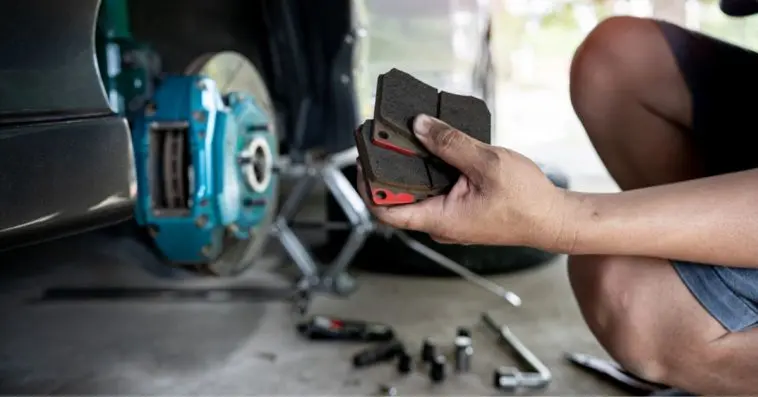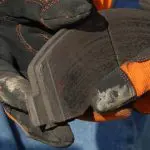At a certain level in the use of any model of the car, the brake pads need to be replaced. This is because they get worn out and thus are unable to get their work done.
This will lead to a poor braking system as well as putting the lives of the passengers at risk in case the brake fails.
Do you know when you should replace your brake pads? Brake pads will need to be replaced when they reach an average of 50,000 miles in mileage.
Since many underlying factors will be considered your brake pads will need to be replaced if you notice any of the following signs:
- An Abnormal Noise When You Apply Brakes
- When the Indicator Lights Are On
- When You Hear Deep Grinding Metal Sound From The Braking System
- Vibrating Brake Pedal
- The Brake Pads Are Less Than ¼ Inch In Thickness
Various signs will show your brake pads need to be replaced. As a car owner, you are recommended to be keen to notice any of the above signs just to be on the safe side.
TABLE OF CONTENTS
5 Factors When You Should Change Your Old Brake Pads
Your brakes are one of the most vital parts of your car that will ensure safety when you are driving your car.
Safety is guaranteed when the components of your braking system are in good condition.
As such, you will need to replace some of the components of the braking system at one point in time.
One such part is the brake pads, which together with the brake calipers and brake rotors form the disc brake system.
There are many signs that will show you need to replace your car brake pads soon; these are discussed below:
1. An Abnormal Noise When You Apply Brakes
A set of brake pads in poor condition will be noticed when your braking system has that consistent and annoying squeak and squealing sound.
While in some weather conditions such as when it is raining heavily, the squeaking might be normal.
However, when the squeaking is persistent even during the dry conditions, then it is high time you have your braking system checked.
2. When The Indicator Lights Are On
Some cars are designed with an advanced mechanism that turns on the brake lights whenever there is an issue with the braking system.
This will trigger the indicator lights to turn on whenever the brake pads are worn out.
When this is the case, an expert would be needed to check the extent of the damage to the braking system.
3. When You Hear Deep Grinding Metal Sound From The Braking System
Some pads are fitted with small metal ridges at the bottom when the brake pads wear out the metal parts will be ground by the rotors or the calipers.
This then leads to a deep grinding metal sound being produced whenever you apply brakes on your car.
This should alert you as the car owner that your brake pads are in bad condition and need to be replaced soon.
In such a situation, if the grinding sound is left to continue for a long while, more damage will be caused.
This happens because the metal ridges grind on metal areas of the braking system and this causes further destruction.
This would then lead to a more expensive cost of repair and replacement needed, which was not necessary in the first place.
4. Vibrating Brake Pedal
When you want to step on the brake pedal in your car and then realize that it is unstable, then the issue might be with the brake pads.
The brake pedal might be vibrating abnormally and this is a sign that the braking system, including the brake pads, is in poor condition and would need repair or replacement.
5. The Brake Pads Are Less than ¼ Inch In Thickness
When you have a look at your brake pads, say when you are changing a tire, and notice that it is less than a 25% its original thickness, then it might be time to replace it.
You can also simply look through the spokes and you will be able to spot the brake pads, when you notice that they have been worn out to a certain extent, then a replacement will be necessary.
Is The Replacing Time Of The Brake Pads Different With Each Car Model?
You will realize that the car model is not a major factor that determines the braking pad replacement time.
This is seen when the miles needed for the car to cover before the brake pads are replaced is not that different.
Instead, factors such as the owner’s driving habits, as well as the driving conditions, determine the replacement time of the brake pads in different car models.
BMW
The brake pads in BMW cars need to be replaced every 50,000 miles.
BMWs are great cars that are designed with advanced technology and are probably popular due to their high performance.
As an owner of a BMW, the 50,000-mile mark would be ideal for you to replace your brake pads, but some other factors should also be considered.
For instance, driving habits will determine the lifespan of the brake pads.
Toyota
For the Toyota model, you would require to replace your brake pads at an average of every 40,000 miles.
In the case of the front wheel, which has its brake pads wearing out faster than the rear wheel, you might need to replace them after every 30,000 miles.
This will vary from the conditions in which the car is being driven in such as the driving style and if the car is driven in either traffic-filled city or the highway, which does not require too much use of the brakes.
The driver’s driving habits, such as their driving speed as well as their type of braking, will also count on the degree of the wear and tear on the brake pads.
Ford
The front brake pads in a Ford car model will need to be replaced after at least 30,000 miles while in general, the brake pads will last for as long as 70,000 miles while others may need to be changed when they reach the 25,000-mile mark.
This will depend on a number of factors, such as the model of Ford that you own, your driving style, or even the environment that you are driving in.
If you drive your Ford car, mainly in the city where the traffic is heavy, you will have to do a lot of braking.
This means that the brakes will be used much more, and this leads to wearing out of the brake pads.
As such, these types of brake pads will have to be replaced more frequently than those driven out of the cities.
Nissan
For the Nissan model cars, the brake pads will need to be replaced every 50,000 miles.
Some brake pads will need to be replaced after 70,000 miles while some will be worn out after just 25,000 miles.
This wholly depends on the conditions that the car is being driven in as well as the driving habits of the driver.
If you are the type of driver that applies to much force on the brake pedal, your brake pads will need to be replaced frequently.
This is because the force applied on the brake pedals is directly proportional to the friction that wears out the brake pads.
Audi
Brake pads in Audi will last for a period ranging between 30,000 and 70,000 miles.
The replacement time here is dependent on the model of the Audi, the materials used in the manufacture of the brake pads as well as your driving habits.
You will realize that ceramic brake pads are long-lasting than most brake pads made from other materials.
Check this article on how long do brake pads last.
It is also seen that some models of the Audi have their brake pads lasting in use more than others.
Subaru
For the Subaru car model, the brake pads will need to be replaced every 25,000 to 70,000 miles. This also depends on the driving habits that the car is being subjected to.
Speeding and harsh braking wears out brake pads faster, and thus they will need to be replaced even before the 30,000-mile mark.
As a driver, if you are into the habit of carrying heavy loads in your Subaru, this will increase the friction on the brake pads. Hence the brake pads tend to wear out faster in this case.
If you also drive your Subaru in the city where you will need to apply a lot of braking as you navigate through the traffic jam, the brake pads wear out faster.
Do You Need To Replace Your Brake Pads When You Replace Rotors?
Yes, when replacing the rotors of your braking system, you will have to replace the brake pads too.
Using a set of old pads will cause problems to the disc braking system. Such problems include uneven wear and cracks that you may not be able to see by yourself.
There will also be some vibrations that will develop as a result of using old brake pads on new brake rotors.
As such new sets of brake pads should be put onto the disc braking system whenever you are either resurfacing or replacing the brake rotors.
How Do You Know When Your Rotors Need To Be Replaced?
You will know whether your brake rotors need replacing when you have a look at the rotors yourself or when you are driving.
You can know this when you go to the wheel and have a look at it if you notice that the rotor either has deep grooves, ridges, or even brake dust filling the groves on it.
Similarly, when you are driving, and you step on the brake pedals and realize that they are either bouncing or pulsating back onto your foot, then one of your rotors is faulty.
This guy in this video also explains when:
What Does A Bad Rotor Sound Like?
Brake rotors that are in poor condition or are severely warped will produce noises. The noise will be heard as squeaky and squealing noise produced from the braking system.
If you notice that the brake pedal appears to be vibrating, then either of your rotors is damaged and needs replacement.
At What Thickness Do Brake Pads Need to Be Replaced?
When your brake pads reach the 3 mm thickness, then you should consider having them replaced.
You can check 10 top-rated brake pads from this page.
Most manufacturers will give an exact minimum thickness that would be needed to avoid before you replace your brake pads.
When it gets to 2 mm, the brake pads will produce a squeaking and squealing sound and this will cause damage to other components of the car braking system.
Is 6mm Good Enough For Brake Pads?
Yes, having your brake pads thickness would be safe for you as well as the other components of your car.
This is because it is far from the alarming 3 mm mark thickness. However, you should know that the brake pads of different cars wear out at varying rates.
You will need to keep a keen eye on the thickness of your brake pads from time to time and even after a certain distance covered.
Conclusion
All in all, to be on the safe side with your car braking system, you must be keen on the condition of your brake pads.
After a certain level of miles, your brake pads will be in poor condition and will need to be replaced.
From the above, you can see 5 signs that will show that your brake pads need to be replaced.
This will help prevent risking the damage of other components of the braking system that might turn out to be rather expensive to replace or repair.
It might also not be safe in a car that has any of the above signs.
Source:
1. Oards Automotive Hub – https://oards.com/when-to-change-brake-pads/




